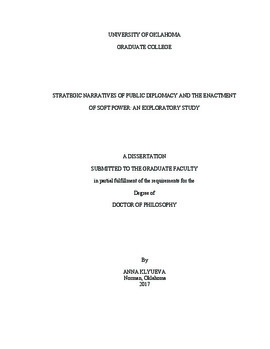| dc.description.abstract | This dissertation investigated the formation, projection, and reception of strategic narratives with the purpose of exploring and explaining how and in what ways soft power can be enacted via strategic narratives. Specifically, utilizing Miskimmon et al.’s (2014) concept of strategic narratives, this dissertation analyzed strategic narratives of Russia to answer the research questions of this exploratory study. The dissertation consisted of three empirical studies. The first study executed a qualitative analysis of the foundational foreign policy documents of Russia to identify the potentially embedded strategic narratives that can be used for projection. The second study conducted a content analysis of Russia's public diplomacy materials to understand what strategic narratives, identified at the level of narrative formation, were embedded in the media materials of two major Russia's public diplomacy outlets: Russia Today and RIA Novosti (Sputnik). The third study analyzed the content of two U.S. elite newspapers, the New York Times and the Washington Post, to identify whether any of Russia’s strategic narratives reached the discursive media environment of the target state. The results from all three studies were then compared and analyzed further.
In general, the findings highlighted several observations. First, strategic narratives that are present at the level of narrative formation are also present at the level of narrative projection and narrative reception, although with varying degree of salience. Second, some strategic narratives at the level of projection and the level of reception exhibited a significant growth during the same period of time, indicating a time-bound need for strategic narratives. Third, strategic narratives’ attributes, such as narrative salience within a story and narrative tone, differed between stages of narrative projection and narrative reception, with narratives being more neutral to positive at the projection and more neutral to negative at the reception. Fourth, speakers of strategic narratives also differed in several ways between stages, with Russian government officials dominating narrative projection and non-Russian government officials and public figures dominating narrative reception. Finally, sources of soft power referenced in strategic narratives at the level of narrative projection were referenced in a similar manner at the level of narrative reception, with the exception of one narrative, indicating that attributes/sources of soft power attraction can fluctuate and be re-framed during the transmission process.
Overall, the dissertation suggests that strategic narratives projected via public diplomacy efforts can be used as tools for the enactment of soft power when strategic narratives emphasize different soft power sources: policies, values, and culture. This argument is based on the assumption that strategic narrative can survive the transmission between stages of narrative formation, narrative projection, and narrative reception. While this assumption has been confirmed by this dissertation, it was also demonstrated that the ability of strategic narratives to reach the discursive environment of the target country does not ensure narrative reception. This observation prompted a conceptualization of an intermediate stage between the narrative projection and narrative reception – narrative diffusion. The proposed diffusion stage captures the previously unexplained concern of how strategic narratives can be received at the stage of narrative reception.
The results of this exploratory research extend and clarify the work of Roselle et al. (2014) on the relationship between strategic narratives and soft power. By addressing the research problem, this dissertation contributes to our understanding of the relationship between soft power and strategic narratives and provides insights into the discursive nature of soft power, illustrating the phenomenon using the case of Russia. This study also elaborated on the contributions of public relations and public diplomacy to the process of soft power enactment. | en_US |
